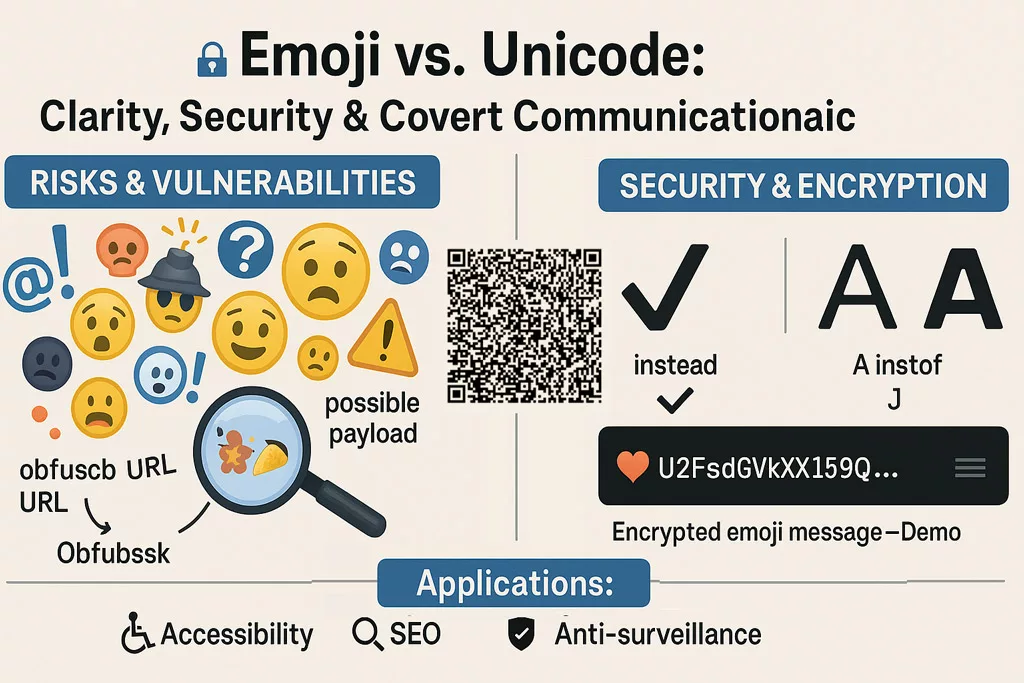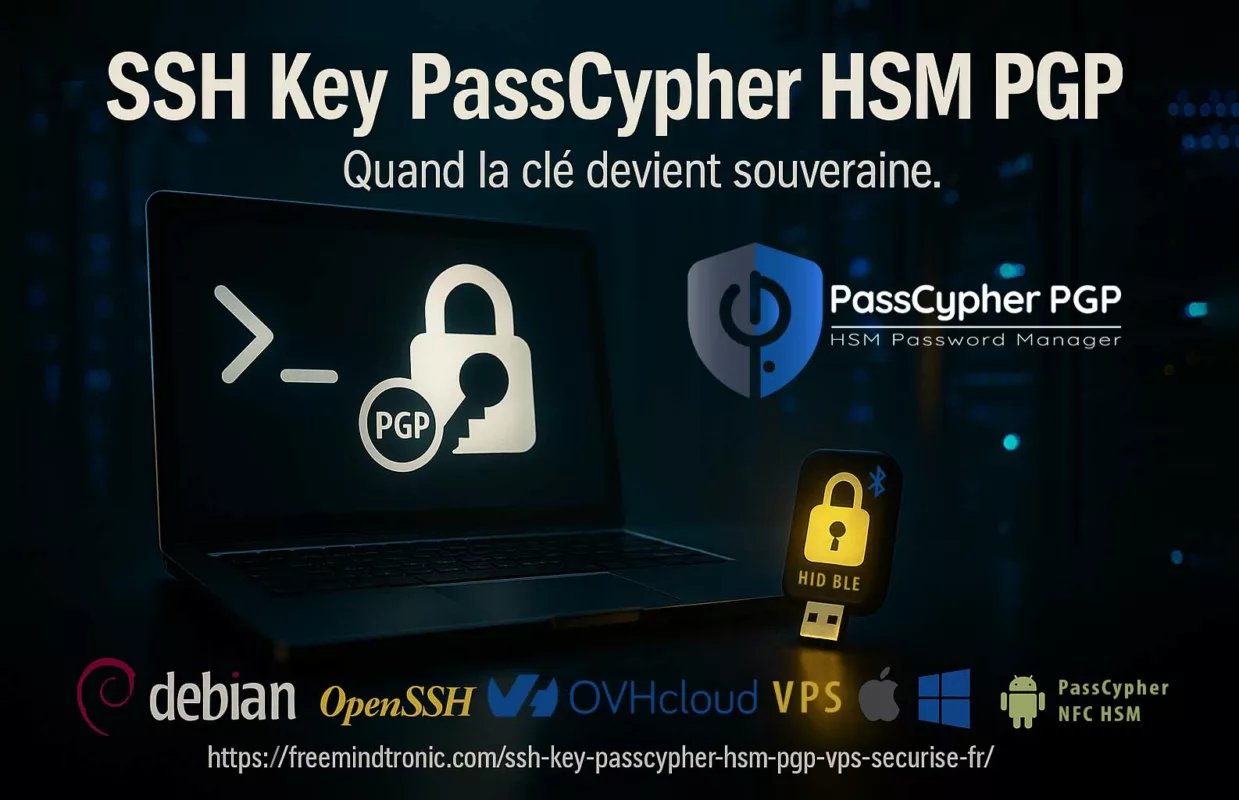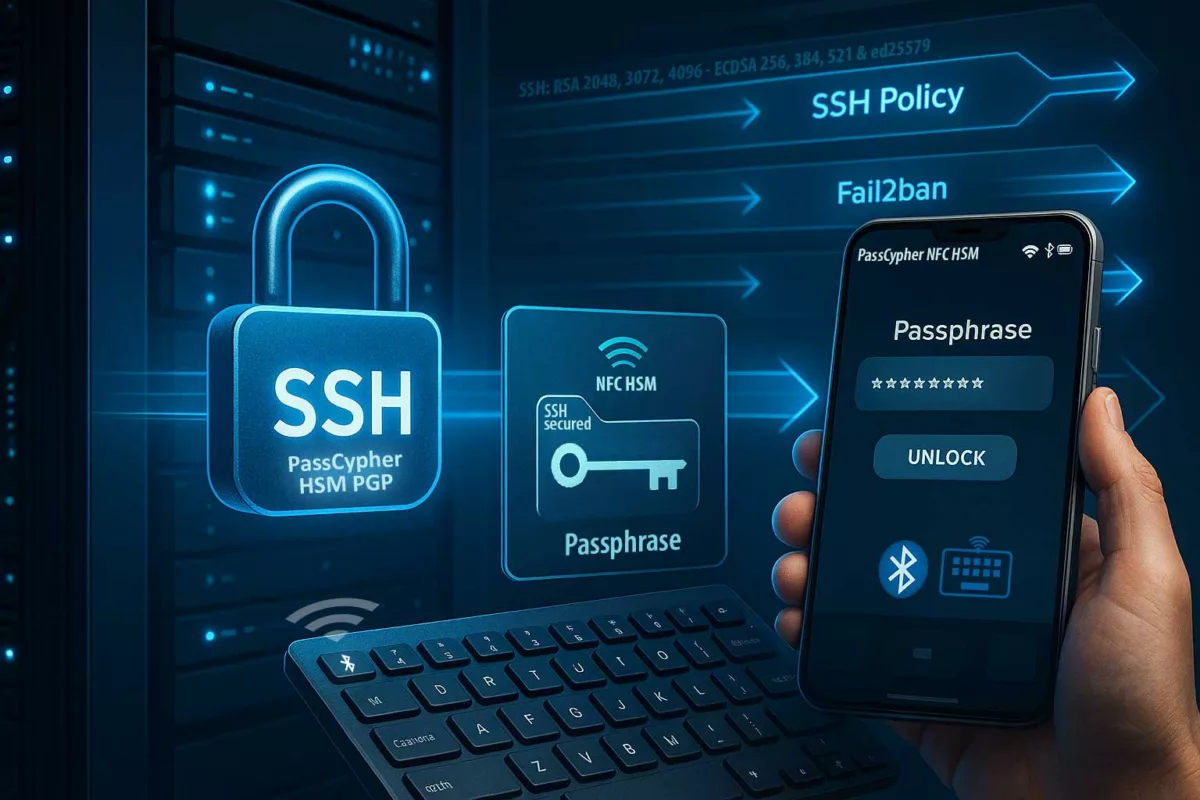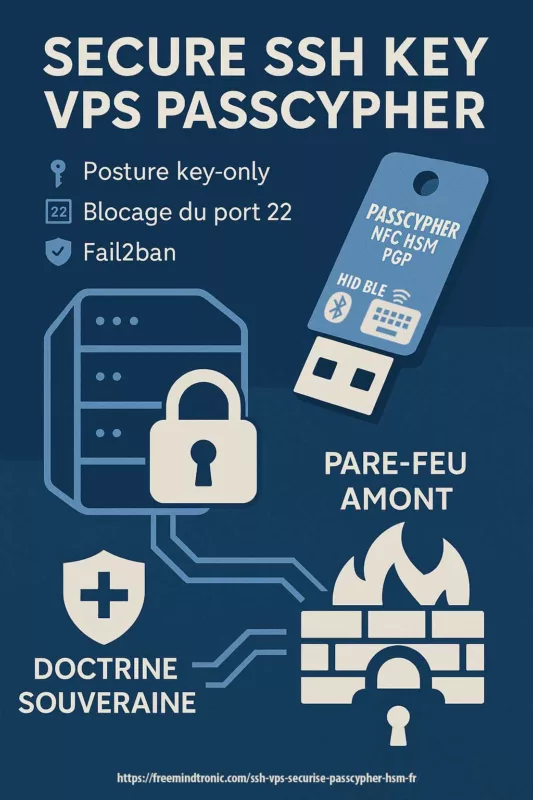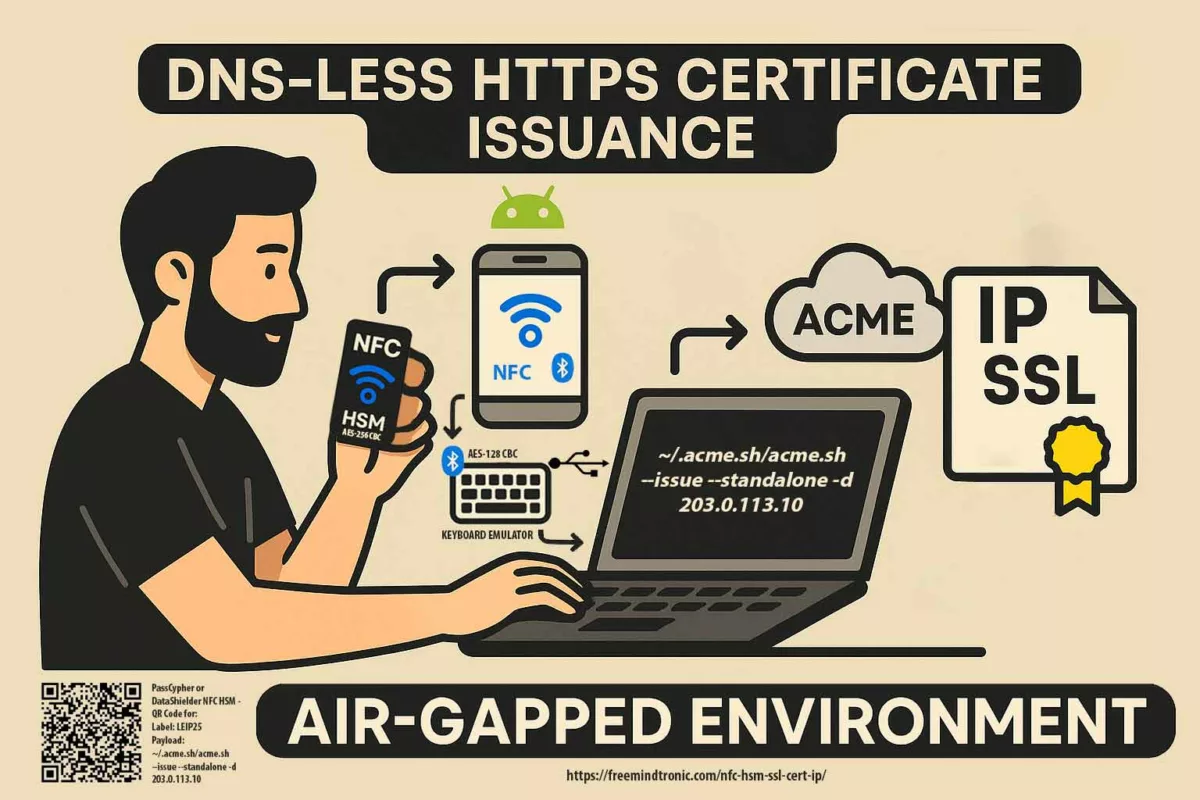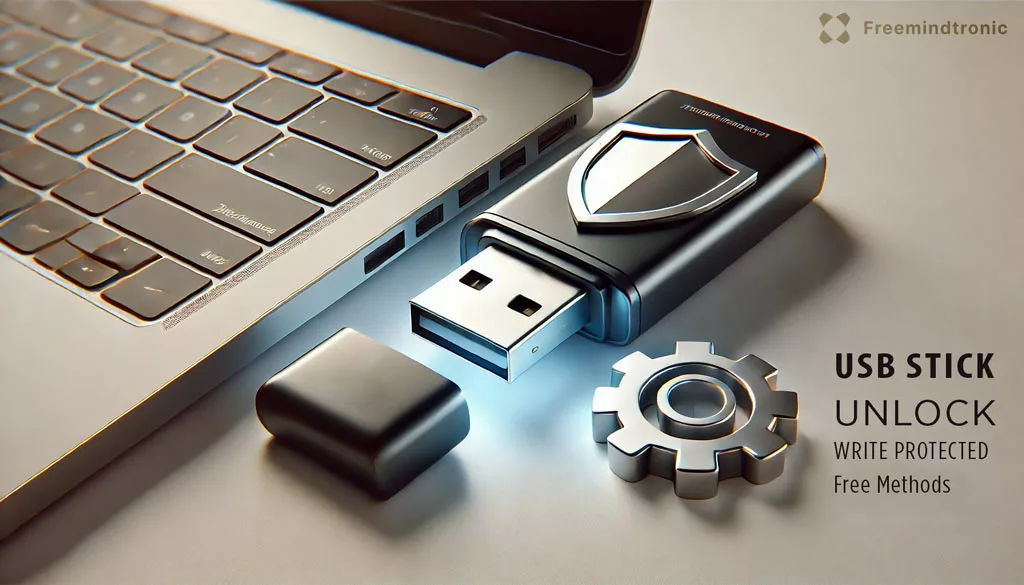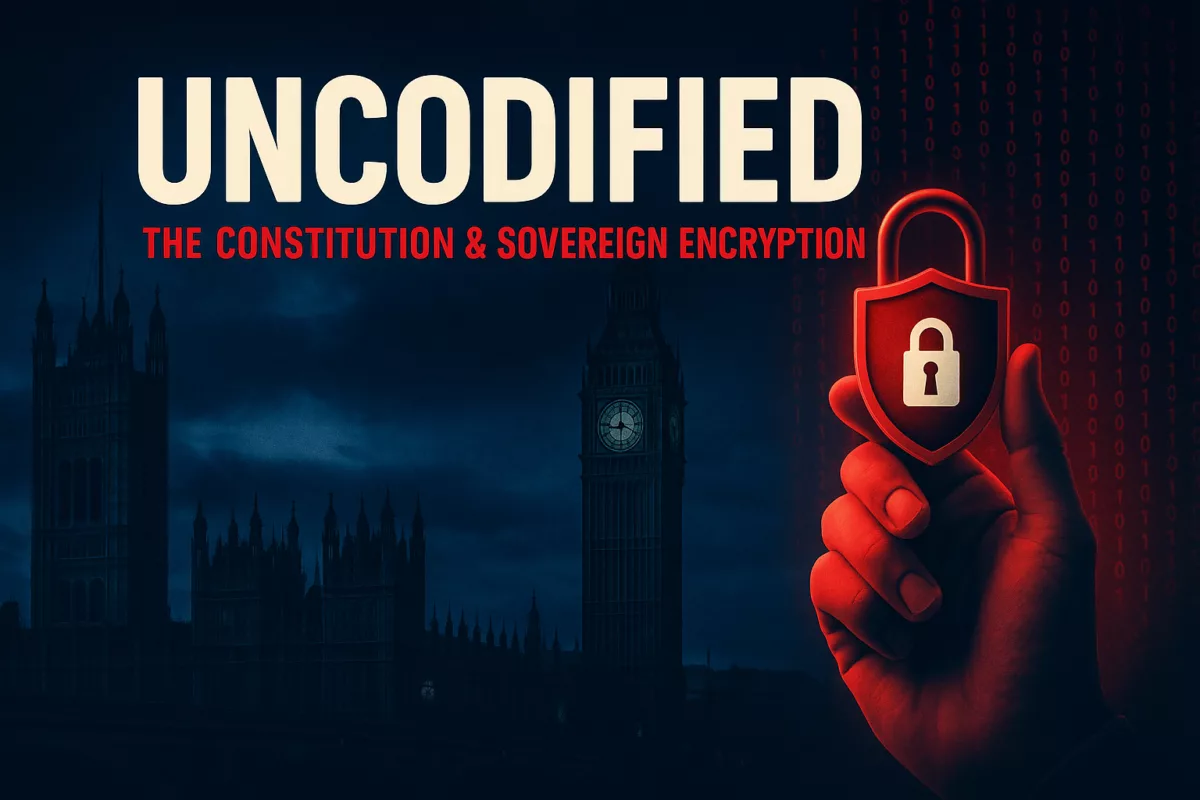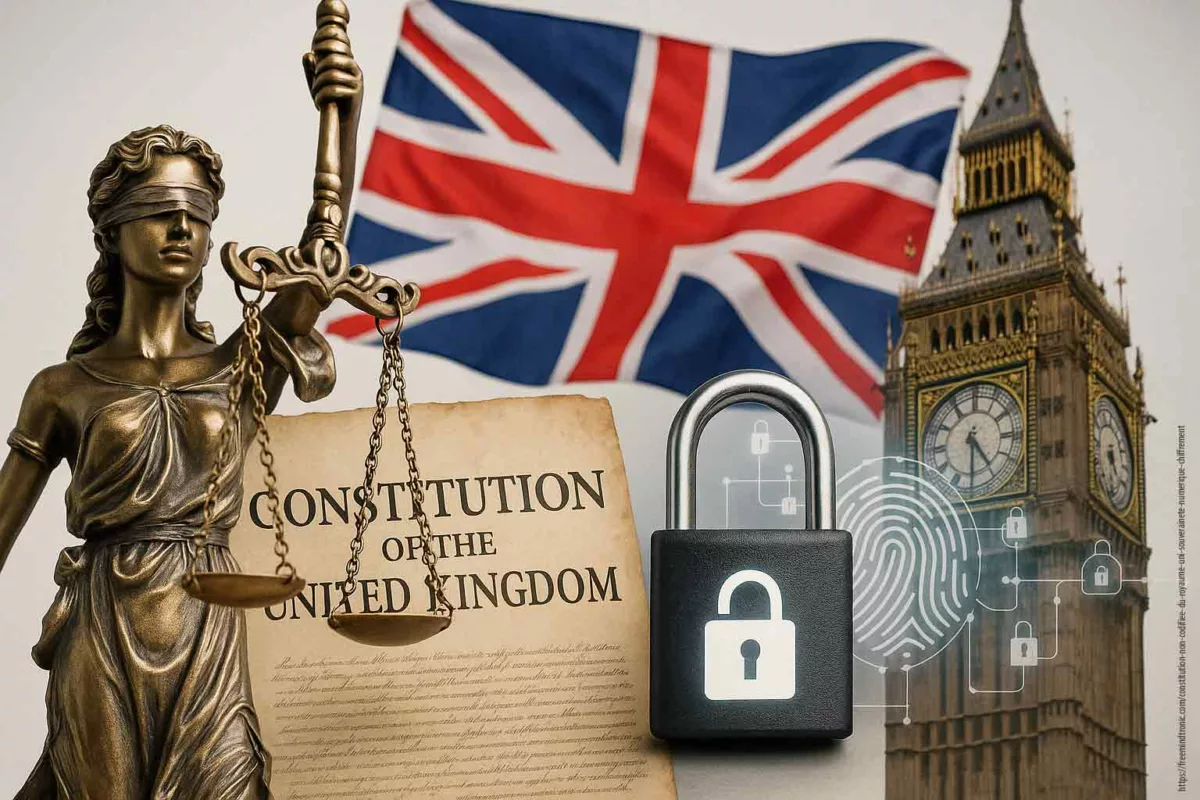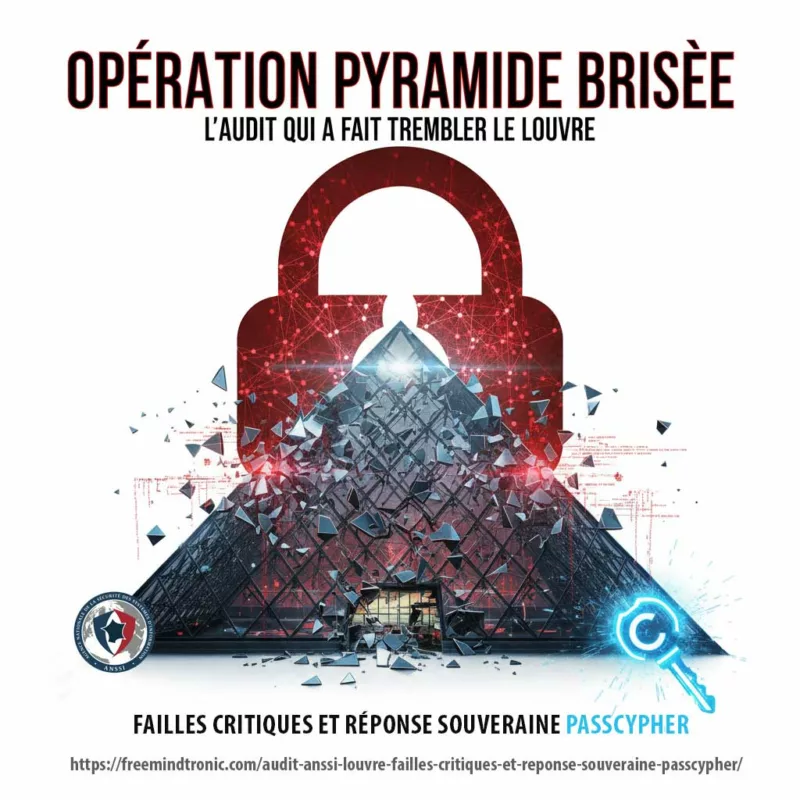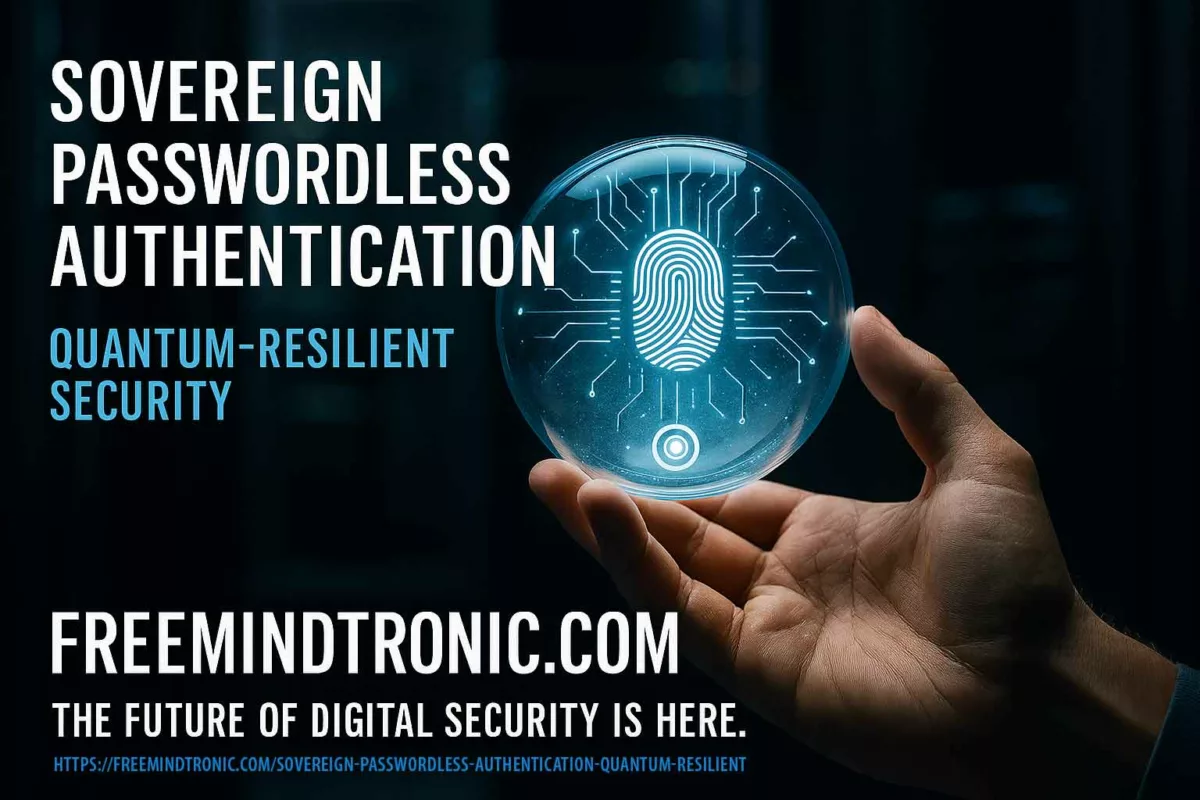Unicode-Based Alternatives to Emojis for Clearer Digital Content
Emoji and character equivalence ensures universal readability, SEO optimization, and accessibility across platforms. Unicode symbols provide a structured and consistent solution for professional, legal, and technical documentation, making them an effective replacement for emojis.
✔ Discover More Digital Security Insights
▼ Explore related articles on cybersecurity threats, advanced encryption solutions, and best practices for securing sensitive data and critical systems. Gain in-depth knowledge to enhance your digital security strategy and stay ahead of evolving risks.
Quick Navigation
‣ Unicode-Based Alternatives to Emojis for Clearer Digital Content
‣ Enhance Content Accessibility and SEO
‣ Why Replace Emojis with Unicode Characters?
‣ Advantages and Disadvantages
‣ Technical Deep Dive on Unicode Encoding
‣ Industry Applications: Legal, Academic, Cybersecurity Cybersecurity Use Cases of Emoji and Character Equivalence
‣ Practical Cybersecurity Use Cases: The Value of Emoji and Character Equivalence
‣ Unicode in SIEM Alerts and Security Logs: A Critical Integration Point
‣ Enhancing Content Security with Emoji and Character Equivalence
‣ Future Trends in Unicode Standardization
‣ Practical Guide: Unicode Implementation
‣ Psychological and Linguistic Impact
‣ Advanced Emoji Exploits: Steganography, Obfuscation, Counterintelligence Dual-Uses
‣ Secure Emoji Encryption Demo – Covert Messaging with AES-256
‣ Unicode vs. Emoji in Prompt Injection Attacks on AI Systems
‣ Unicode and Internationalization for Global SEO
‣ How to Apply Emoji and Character Equivalence Today
‣ Best Unicode Equivalents for Emojis
‣ Official Sources and References
Enhance Content Accessibility and SEO: The Complete Guide to Unicode Alternatives for Emojis
Emojis have become ubiquitous in our digital communication, adding a layer of emotion and personality to our texts. However, their inconsistent display across platforms and the challenges they pose in terms of accessibility and search engine optimization (SEO) underscore the necessity of exploring more reliable alternatives. This guide delves deeply into how Unicode characters offer a structured and universal solution for digital content that is clear, accessible, and optimized for SEO, including considerations for cybersecurity communication.
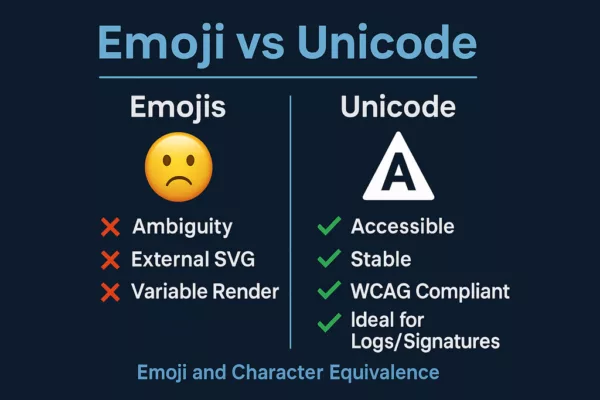
Infographic showing Emoji and Character Equivalence with a visual comparison of the limitations of emojis versus the cybersecurity benefits of Unicode characters. Visual breakdown of Emoji and Character Equivalence: Unicode is more secure, accessible, and reliable than emojis for cybersecurity contexts.
Why Opt for Unicode Characters Over Emojis?
The concept of emoji and character equivalence is essential for ensuring content consistency, optimizing SEO, and improving accessibility, as well as maintaining clarity in fields like cybersecurity. While emojis enhance engagement, their display varies depending on platforms, devices, and browsers, making Unicode characters a reliable and universal alternative for accessible content, better search ranking, and precise cybersecurity communication.
✔ Advantages
- Universal Compatibility – Unicode characters are recognized across all systems and browsers, ensuring consistent display, crucial for reliable cybersecurity information.
- Enhanced Accessibility – Assistive technologies interpret Unicode characters more efficiently than emojis, contributing to better compliance with web accessibility guidelines (WCAG), vital for inclusive cybersecurity resources.
- SEO Optimization – Special characters are indexed correctly by search engines, ensuring better visibility in search results, including searches related to cybersecurity symbols. Strategic use in titles and descriptions can also attract attention for improved SEO in the cybersecurity domain.
- Professional Consistency – Utilizing Unicode formatting is more suited to legal, academic, and business communications, including cybersecurity reports and documentation, where clarity and precision are paramount. The ambiguous nature of emojis can lead to misunderstandings, especially in sensitive fields like cybersecurity.
- Performance Considerations – Emojis can sometimes be rendered as images, especially on older systems, potentially increasing page load times compared to lightweight Unicode text characters, thus impacting site performance and potentially SEO, including for websites providing cybersecurity information.
✘ Disadvantages
- Reduced Visual Appeal – While emojis capture attention with their colorful graphic nature (for example, a simple 😊, their Unicode equivalent (U+263A, ☺) is a textual character. While the latter ensures compatibility, it can have a less immediate visual impact on user engagement, potentially affecting the perceived urgency of cybersecurity alerts.
- Limited Expressiveness – Unicode characters lack the emotional depth and visual cues of emojis, which might be relevant in less formal cybersecurity community discussions.
- Formatting Challenges – Inserting certain Unicode symbols, such as complex directional arrows (e.g., U+2913, ⤓) or specific mathematical symbols (e.g., U+222B, ∫), may require memorizing precise Unicode codes or using character maps, which can be less intuitive than selecting an emoji from a dedicated keyboard, potentially slowing down the creation of cybersecurity content.
Enhancing Content Security with Emoji and Character Equivalence
Recent research highlights critical cybersecurity risks associated with emoji usage. While emojis improve engagement, their hidden vulnerabilities can pose security threats. Understanding Emoji and Character Equivalence helps mitigate these risks while ensuring accessibility and SEO optimization.
✔ Emojis as Hidden Payloads Cybercriminals embed tracking codes or malware within emojis, particularly when encoded as SVG assets or combined with Zero Width Joiner (ZWJ) characters. This technique allows threat actors to deliver hidden payloads undetected, making Unicode characters a safer alternative.
✔ Misinterpretation Across Cultures and Legal Implications The visual representation of emojis varies by region, often leading to miscommunication or legal disputes. Unicode characters provide a standardized approach, avoiding ambiguity in contracts, digital agreements, and cross-cultural messaging.
✔ Accessibility Challenges for Screen Readers Screen readers may translate emojis inaccurately, generating verbose or misleading descriptions for visually impaired users. Relying on Unicode characters enhances clarity, ensuring consistent accessibility across assistive technologies.
✔ SEO Performance and Metadata Impact Emojis in SEO metadata may increase click-through rates, but their inconsistent rendering across platforms limits indexation reliability. Implementing Unicode characters ensures better search engine readability, reinforcing structured content strategies.
Official Sources on Emoji Vulnerabilities
- Smuggling Data Through Emojis – Paul Butler’s Research
- Cultural Misinterpretations of Emojis – Emoji Code Analysis
- Screen Reader Accessibility Issues – Scope Business
- SEO Risks of Emoji Use – ContentPowered SEO Report
By embracing Emoji and Character Equivalence, digital creators strengthen security, accessibility, and search visibility. Unicode characters offer a stable and universally recognized alternative, ensuring that content remains optimized and protected across platforms.
Technical Deep Dive on Unicode Encoding for Emojis and Symbols in Cybersecurity Contexts
✔ Understanding How Unicode Encodes Emojis and Special Characters for Cybersecurity Unicode assigns a unique code point to each emoji, enabling its display across various operating systems. However, rendering depends on the platform, leading to variations in appearance. For example, the red heart emoji (❤️) has the Unicode code U+2764 followed by the emoji presentation sequence U+FE0F. When used in text mode (without U+FE0F), it may appear as a simple black heart (♥, U+2665) depending on the font and system. Special characters like the checkmark (✔) have a unique code (U+2714) and are rendered consistently as text, aiding in content accessibility for cybersecurity professionals
✔ Emoji Presentation Sequences vs. Text Presentation Sequences in Unicode for Cybersecurity Communication Some Unicode characters exist both as text and emoji versions. Presentation sequences determine whether a character displays as a graphic emoji or as standard text. For example, the Unicode character for a square (□, U+25A1) can be displayed as a simple text square. By adding the emoji presentation sequence (U+FE0F), it may be rendered as a colored square on some platforms if an emoji style for that character exists. This distinction is crucial for both visual presentation and SEO considerations, especially for cybersecurity platforms.
It’s also important to note that some Unicode symbols are “combining characters.” These are designed to be overlaid onto other characters to create new glyphs. For instance, adding an accent to a letter involves using a combining accent character after the base letter, which might have niche applications in specific cybersecurity notations.
Industry-Specific Applications of Unicode Characters for Professional Content, Including Cybersecurity
✔ Using Unicode in Legal and Academic Documents Unicode characters are preferred over emojis in contracts, academic papers, and official reports, where consistency and professionalism are essential for clear communication. The ambiguous nature of emojis can lead to misinterpretations in legally binding documents, making standardized characters a safer choice, which also applies to the formal documentation within the cybersecurity industry.
✔ Leveraging Unicode in Cybersecurity and Technical Documentation Security experts and programmers use Unicode symbols in programming languages, encryption protocols, and cybersecurity reports for precision and clarity in technical content. For example, in code, Unicode symbols like logical operators (e.g., ∀ for “for all,” ∃ for “there exists”) or arrows (→, ←) are used for precise notation. In cybersecurity reports, specific alert symbols (⚠, ☢, ☣) can be used in a standardized way to convey specific threat levels or types, enhancing information accessibility for cybersecurity professionals..
✔ Corporate Branding with Unicode for Consistent Visual Identity, Including Cybersecurity Firms Many companies integrate Unicode characters into branding materials to ensure consistent representation across marketing assets. Some companies subtly incorporate Unicode characters into their text-based logos or communication to create a unique and consistent visual identity across platforms where typography is limited, contributing to brand recognition in search results, including for cybersecurity companies. For example, a tech brand might use a stylized arrow character or a mathematical symbol to evoke innovation and security.
Practical Cybersecurity Use Cases: The Value of Emoji and Character Equivalence
For cybersecurity professionals, adopting Emoji and Character Equivalence goes far beyond visual consistency — it strengthens secure communication, ensures compatibility across platforms, and reduces attack surfaces. Below are key scenarios where this principle makes a strategic difference.
✔ Use Case 1: Security Alert Bulletins
A CISO distributes a critical vulnerability bulletin using the emoji ⚠️. On some outdated terminals or filtered environments, the emoji fails to render or displays incorrectly.
✅ Unicode Advantage: Using U+26A0 (⚠) ensures universal readability, including by screen readers and legacy systems, supporting clear and actionable cybersecurity communication.
✔ Use Case 2: Secure Internal Messaging
In secure mail systems, emojis may be blocked or replaced to prevent the loading of external SVG assets, which can introduce vulnerabilities.
✅ Unicode Advantage: With Emoji and Character Equivalence, using Unicode characters instead of emojis eliminates these external dependencies while preserving the intended meaning and visual cue.
✔ Use Case 3: Signed System Logs and Forensics
Emojis rendered as images or platform-dependent glyphs can cause inconsistencies in cryptographic hash comparisons during log audits or forensic analysis.
✅ Unicode Advantage: Unicode characters have a stable code point (e.g., U+2714 for ✔), ensuring that logs remain verifiable across environments, crucial for integrity and non-repudiation in cybersecurity workflows.
These examples demonstrate how implementing Emoji and Character Equivalence is not only a matter of formatting — it’s a tactical choice to improve clarity, compliance, and reliability in cybersecurity communication.
Unicode in SIEM Alerts and Security Logs: A Critical Integration Point
Security Information and Event Management (SIEM) systems rely on structured, machine-readable alerts. Emojis—often rendered as platform-dependent graphics or multibyte sequences—can disrupt formatting, corrupt parsing logic, and complicate forensic investigations.
✅ Unicode characters such as U+26A0 (Warning: ⚠), U+2714 (Check mark: ✔), and U+2717 (Cross mark: ✗) provide:
- Stable rendering across terminals, dashboards, and log collectors.
- Consistent cryptographic hashing in signed event logs.
- Reliable pattern matching in SIEM rules and regular expressions.
- Screen reader compatibility for accessible security dashboards.
Example:
Instead of inserting a graphical emoji into a high-severity alert, use U+2717 (✗) for guaranteed interpretability across systems and tools.
This Unicode-based strategy ensures compatibility with:
- Automated threat detection pipelines
- Regulatory compliance tools
- SIEM log normalization engines
- Long-term forensic retention archives
Unicode brings predictability, clarity, and durability to cybersecurity event management—core to any zero-trust and audit-ready architecture.
Case Study: Emoji-Based Vulnerabilities and Cybersecurity Incidents
While emojis may appear innocuous, documented cyberattacks have demonstrated that they can be exploited due to their complex rendering behavior, reliance on external assets (like SVG), and ambiguous encoding. These cases reinforce the importance of adopting Emoji and Character Equivalence practices, especially in cybersecurity contexts where clarity, stability, and accessibility are critical.
⚠ Unicode Rendering Crash (Unicode “Bombs”)
➔ In 2018, a sequence of Unicode characters — including a Telugu glyph and modifiers — caused iPhones to crash and apps like iMessage to freeze. This vulnerability stemmed from how Apple’s rendering engine mishandled complex Unicode sequences.
✔ Sources officielles :
• MacRumors – iOS Unicode Crash Bug: https://www.macrumors.com/2018/02/15/ios-11-unicode-crash-bug-indian-character/
• BBC News – iPhone crash bug caused by Indian character: https://www.bbc.com/news/technology-43070755
⚠ Malicious SVG Rendering in Messaging Platforms
➔ Some messaging platforms like Discord rendered emojis through external SVG files, introducing a surface for remote code injection or tracking. Attackers exploited this to embed malicious content through emoji payloads.
✔ Source officielle :
• Dark Reading – Emojis Control Malware in Discord Spy Campaign: https://www.darkreading.com/remote-workforce/emojis-control-malware-discord-spy-campaign
⚠ Unicode Spoofing and Invisible Character Obfuscation
➔ Emojis combined with zero-width characters such as U+200B (Zero Width Space) or U+200D (Zero Width Joiner) have been used in phishing URLs and obfuscated code. These tactics enable homograph attacks that mislead readers or bypass detection.
✔ Documentation technique :
• Unicode Consortium – UTS #39: Unicode Security Mechanisms: https://unicode.org/reports/tr39/
✔ Strategic Takeaway
✘ Emojis rely on platform-dependent rendering and can introduce inconsistency or vulnerabilities.
✔ Unicode characters use immutable code points and render reliably across systems — making them ideal for cybersecurity logs, alerts, and accessible content.
The adoption of Emoji and Character Equivalence ensures professional-grade security, readability, and integrity.
⚠ Emoji Shellcoding and Obfuscated Command Execution
Recent threat research and demonstrations (e.g., DEFCON30, August 2022) have shown how non-ASCII characters, including Unicode symbols, can be used to obfuscate shell commands, bypassing traditional keyword-based detections. Attackers leverage Unicode manipulation to evade security filters, making detection more challenging.
🔗 Further Reading: Command-Line Obfuscation Techniques
⚠ Real-World Example
reg export HKLMSAM save.reg
When disguised using invisible Unicode characters (such as U+200D, U+200B), this command may appear harmless but still executes a privileged registry dump, bypassing conventional security checks.
🛠 Recommended Security Measures
✔ Regex-Based Detection – Go beyond keyword matching to identify command patterns, even if partially encoded or visually disguised.
✔ Alerting on Anomalous Characters – Security systems (SIEM, EDR, XDR) should flag commands containing:
- Unicode Special Characters (U+2714, U+20AC, etc.)
- Non-Printable Characters (U+200D, U+200B)
- Zero Width Joiners or Spaces (U+200D, U+200B)
✅ Unicode Benefit
By restricting input/output to ASCII or validated Unicode, organizations can: ✔ Minimize obfuscation risks ✔ Strengthen parsing and logging integrity ✔ Improve detection accuracy across terminal, script, and web layers
By implementing advanced detection techniques, organizations can mitigate risks associated with Unicode-based obfuscation and strengthen cybersecurity defenses.
Future Trends in Unicode and Emoji Standardization
✔ Updates from the Unicode Consortium on Emoji and Character Sets for Technical Fields Like Cybersecurity The Unicode Consortium regularly evaluates emoji proposals and updates the Unicode standard. Decisions are based on cultural relevance, accessibility needs, and demand from users, including potential requests for standardized symbols relevant to cybersecurity. Staying informed about Unicode updates is key for future content optimization, especially for technical documentation and cybersecurity communication.
✔ Challenges in the Standardization of Emojis and Unicode for Precise Technical Communication The standardization process faces obstacles due to regional interpretations of emojis, varying display standards, and accessibility concerns for visually impaired users. The interpretation of emojis can vary significantly depending on context and cultural differences. Artificial intelligence may play an increasing role in understanding the meaning of emojis in different contexts, but standardization for universal interpretation remains a complex challenge, highlighting the ongoing importance of clear Unicode alternatives, particularly in technical fields like cybersecurity where precision is critical.
Practical Implementation Guide: Replacing Emojis with Unicode for Better SEO, Accessibility, and Cybersecurity Communication
✔ How to Implement Unicode in Web Content for SEO, Accessibility, and Cybersecurity Clarity
- WordPress: Use Unicode characters directly in text fields for SEO-friendly content, including cybersecurity blogs and articles.
- HTML: Insert Unicode using &#code; notation (e.g., ✔ for ✔, ⚠ for ⚠) to ensure accessible HTML, especially for cybersecurity warnings and alerts.
- Markdown: Use plain text Unicode values for seamless integration in SEO-optimized Markdown, including cybersecurity documentation.
- CSS: Apply Unicode as
contentproperties in stylesheets for consistent rendering and potential SEO benefits, including unique styling of cybersecurity-related symbols. - Other CMS: For platforms like Drupal or Joomla, Unicode character insertion is usually done via the WYSIWYG text editor (using the special character insertion feature) or directly in the HTML code for accessible content management, including cybersecurity resources.
- Mobile Applications: Mobile app development for iOS and Android allows direct integration of Unicode characters into text strings, ensuring accessibility on mobile, including cybersecurity applications and notifications. Mobile operating system keyboards also often provide access to special characters via contextual menus or dedicated symbol keyboards.
✔ Keyboard Shortcuts for Typing Unicode Symbols Easily, Including Cybersecurity Symbols
- Windows: Use Alt + Unicode code (e.g., Alt + 2714 for ✔, Alt + 26A0 for ⚠) for quick Unicode input, including symbols used in cybersecurity.
- Mac: Press Cmd + Control + Spacebar to access Unicode symbols conveniently, useful for inserting cybersecurity-related characters.
- Linux: Type Ctrl + Shift + U + Unicode code for Unicode character entry, including specific cybersecurity symbols.
Psychological and Linguistic Impact of Emoji vs. Unicode Characters on Communication
✔ Analyzing How Emojis Affect Digital Communication, Including the Ambiguity in Cybersecurity Contexts Emojis are widely used to express emotions, tone, and intent, but their interpretation differs culturally, leading to ambiguity in professional exchanges, which can be particularly problematic in cybersecurity alerts or warnings where clear and unambiguous communication is vital. A simple thumbs-up (👍) could be misinterpreted in a critical cybersecurity discussion.
✔ The Role of Unicode Characters in Enhancing Readability and Clarity, Especially in Technical and Cybersecurity Content Symbols such as ✔, ✉, ⚡, ⚠, 🔒 provide structured communication that is easier to process and interpret objectively in technical content, improving content accessibility, especially in the cybersecurity domain. The use of standardized Unicode symbols in technical or legal documents (like checkmarks to validate points, arrows to indicate steps, or precise currency symbols) reinforces the perception of rigor, clarity, and professionalism of the content, which is paramount in cybersecurity reports and documentation, and can indirectly benefit user trust and SEO for cybersecurity resources.
Unicode vs. Emoji in Prompt Injection Attacks on AI Systems
Recent studies have revealed that emojis—beyond visual ambiguity—can act as covert payloads in AI prompt injection attacks. While most text is tokenized into multiple units by large language models (LLMs), emojis are often treated as single-token sequences. This allows attackers to hide complex instructions inside what appears to be a harmless character.
⚠ Real-World Finding:
Some emojis can expand into over 20 hidden tokens, bypassing security filters designed to detect explicit instructions.
This stealth mechanism stems from:
- LLMs treating emojis as atomic units,
- Emojis encoding metadata or invisible sequences (e.g., Zero Width Joiners),
- Models inherently trying to interpret non-standard patterns to “solve” them.
🔐 Security Implication:
These injection techniques exploit the architecture of transformer-based models, where unexpected inputs are treated as puzzles to decode. This behavior turns visual glyphs into logic bombs capable of triggering unintended actions.
✅ Unicode Advantage in AI Contexts:
Unicode characters:
- Have transparent tokenization (predictable encoding),
- Avoid compound emoji sequences and visual ambiguity,
- Don’t carry extra layers of metadata or emoji-style modifiers (e.g.,
U+FE0F).
Using Unicode-only inputs in AI workflows enhances:
- Prompt sanitization,
- Filter robustness,
- Audit trail clarity.
Example:
Using U+2714 (✔) instead of ✅ ensures that the LLM interprets it as a basic semantic unit, not a potential instruction carrier.
By preferring Unicode over emojis in LLM prompts and logs, developers reduce the surface for prompt injection and enhance traceability in AI-assisted workflows. This is particularly vital in secure automation pipelines, compliance monitoring, and zero-trust content generation environments.
⚠ Emojis in Cybercrime and OSINT: A Silent Language of the Dark Web
While emojis are often seen as harmless digital expressions, they are increasingly exploited by cybercriminals as a covert communication method on the dark web. Their ambiguity, cross-platform rendering inconsistencies, and social familiarity make them ideal for masking illicit content.
✔ Use in Illicit Marketplaces: Emojis are used to denote illegal goods and services in Telegram groups, forums, and marketplaces. For example, 💉 might refer to drugs, while 🔫 can imply weapons.
✔ Bypassing Detection: Because most cybersecurity tools and SIEMs focus on keyword detection, emoji-based language can evade filters. Attackers use them as part of “visual slang” that security systems don’t flag.
✔ The Rise of Emoji Forensics: Cyber investigators and OSINT professionals are mapping known emoji patterns used by criminal groups. Some tools are being trained to detect, interpret, and alert on specific emoji combinations.
✔ Generational Risk: Younger users (Gen Z), who communicate heavily via emojis, are at greater risk of exposure or manipulation in these covert communication schemes.
✔ Unicode Advantage: Unicode characters provide clear, unambiguous alternatives to emojis for secure communications. They allow enforcement and detection systems to parse logs, messages, and forensic data with higher accuracy.
🔗 Unlocking Digital Clues: Using Emojis in OSINT Investigations – Da Vinci Forensics This article explores how emojis serve as digital fingerprints in OSINT investigations, helping analysts track illicit activities, identify behavioral patterns, and uncover hidden communications.
This growing misuse of emojis signals a need for more refined detection systems and public awareness around their evolving role in digital crime.
Advanced Emoji Exploits: Steganography, Obfuscation, and Counterintelligence Uses
Beyond spoofing and prompt injection, emojis are being employed in advanced cyber tactics such as steganographic payloads, command injection evasion, and even counterespionage decoys.
✔ EmojiCrypt – Obfuscating Prompts for Privacy: Researchers have introduced “EmojiCrypt,” a technique that encodes user prompts in emojis to preserve privacy during LLM interaction. The visual string appears nonsensical to humans, while remaining interpretable by the AI, enabling obfuscated instruction handling without leaking intent.
✔ Emoti-Attack – Subverting NLP with Emoji Sequences: Emoti-Attack is a form of adversarial input that disrupts NLP interpretation by inserting harmless-looking emoji patterns. These can influence or derail the LLM’s understanding without detection.
✔ Counterintelligence and Deception: Unicode characters offer a countermeasure. Security researchers have demonstrated the use of Unicode formatting as a defensive tool: creating decoy messages embedded with Unicode traps that reveal or mislead adversarial AI crawlers or language models scanning open-source intelligence (OSINT) feeds.
✔ Forensic Importance: Understanding emoji misuse can assist forensic investigators in analyzing chat logs, malware payloads, and behavioral indicators, particularly in APT campaigns or disinformation efforts.
Unicode’s transparency, immutability, and predictability make it a valuable component of digital countermeasures in cybersecurity and OSINT.
Dual-Use Encryption via Emoji Embedding
Dual-Use Communication: Encrypted Emoji Payloads in Secure Civil and Military Applications
While most discussions emphasize the risks posed by emojis in digital communication, Freemindtronic has also demonstrated that these same limitations can be harnessed constructively. Leveraging their expertise in air-gapped encryption and segmented key systems, Freemindtronic uses emoji-embedded messages as covert carriers for encrypted content in secure, offline communication workflows.
✔ Operational Principle
Emoji glyphs can embed encrypted payloads using layered Unicode sequences and optional modifiers (e.g., U+FE0F). The visual result appears trivial or humorous, but can encode AES-encrypted messages that are only interpretable by a paired Freemindtronic decryption system.
✔ Use Cases in Civilian and Defense Fields
- Civil: Secure broadcast of contextual alerts (e.g., logistics, health) across untrusted channels using visually benign symbols.
- Military: Covert transmission of encrypted instructions via messaging systems or printed media, decodable only by pre-authorized HSM-equipped terminals.
✔ Advantages Over Traditional Payload Carriers
- Emojis are widespread and rarely filtered.
- Appear non-threatening in hostile digital environments.
- Compatible with zero-trust architectures using offline HSMs.
- Seamless integration into printed formats, signage, or NFC-triggered displays.
✔ Security Implication
This dual-use capability turns emojis into functional steganographic containers for encrypted instructions, authentication tokens, or contextual messages. By pairing emoji-based visuals with secure decryption modules, Freemindtronic establishes a trusted communication channel over inherently insecure or surveilled platforms.
Strategic Takeaway:
What is often seen as a vector of attack (emoji-based obfuscation) becomes—under controlled, secure systems—an innovative tool for safe, deniable, and ultra-lightweight communication across civilian and military domains.
Secure Emoji Encryption Demo – Covert Messaging with AES-256
Unicode and Internationalization for Global Content Reach
Unicode’s strength lies in its ability to represent characters from almost all writing systems in the world. This makes it inherently suitable for multilingual content, ensuring that special characters and symbols are displayed correctly regardless of the language, which is crucial for global SEO and disseminating cybersecurity information internationally. While emojis can sometimes transcend language barriers, their visual interpretation can still be culturally influenced, making Unicode a more stable choice for consistent international communication of symbols and special characters, improving accessibility for a global audience accessing cybersecurity content.
How to Apply Emoji and Character Equivalence Today for Content Optimization
✔ your content – Identify areas where Unicode replacements improve accessibility and compatibility, contributing to WCAG compliance and better SEO, as well as enhancing the clarity and professionalism of cybersecurity communications.
✦ Use structured formatting – Incorporate Unicode symbols while maintaining clarity in digital communication for improved readability and SEO, especially in technical fields like cybersecurity.
➔ Test across platforms – Verify how Unicode alternatives appear on various browsers and devices and ensure font compatibility for optimal accessibility and user experience, particularly for users accessing cybersecurity information on different systems.
✉ Educate your audience – Inform users why Unicode-based formatting enhances readability and usability, indirectly supporting SEO efforts by improving user engagement with even complex topics like cybersecurity.
By integrating emoji and character equivalence, content creators can future-proof their digital presence, ensuring clarity, accessibility, and universal compatibility across platforms, ultimately boosting SEO performance and user satisfaction, and fostering trust in the accuracy and professionalism of cybersecurity content.
⚡ Ready to optimize your content?
Start incorporating Unicode symbols today to enhance content structure and readability while optimizing accessibility! This is particularly important for ensuring clear and unambiguous communication in critical fields like cybersecurity. We encourage you to share your experiences and further suggestions in the comments below.
Best Unicode Equivalents for Emojis
Using Emoji and Character Equivalence enhances consistency, accessibility, and professional formatting. The table below categorizes key Unicode replacements for emojis, ensuring better SEO, readability, and universal compatibility.
✅ Validation & Security
| Emoji | Special Character | Unicode | Description |
|---|---|---|---|
| ✅ | ✔ | U+2714 | Validation checkmark |
| ☑ | ☑ | U+2611 | Checked box |
| ✓ | ✓ | U+2713 | Simple validation tick |
| 🗸 | 🗸 | U+1F5F8 | Alternative tick symbol |
| 🔒 | ⛨ | U+26E8 | Protection symbol |
| ⚠️ | ⚠ | U+26A0 | Warning or alert |
| ☢ | ☢ | U+2622 | Radiation hazard |
| ☣ | ☣ | U+2623 | Biohazard |
| ❌ | ✗ | U+2717 | Cross mark for rejection |
| ❌ | ✘ | U+2718 | Alternative cross for errors |
🧾 Documents & Markers
| Emoji | Special Character | Unicode | Description |
|---|---|---|---|
| 📌 | ✦ | U+2726 | Decorative star or marker |
| 📖 | 📚 | U+1F4DA | Books (Reading) |
| 📖 | ╬ | U+256C | Document symbol |
| 📥 | ⬇ | U+2B07 | Download arrow |
| 📤 | ⬆ | U+2B06 | Upload arrow |
| 📦 | 🗄 | U+1F5C4 | Storage box |
| 📩 | ✉ | U+2709 | Email or message icon |
| 📍 | ❖ | U+2756 | Location marker |
🧭 Arrows & Directions
| Emoji | Special Character | Unicode | Description |
|---|---|---|---|
| → | → | U+2192 | Right arrow |
| ← | ← | U+2190 | Left arrow |
| ↑ | ↑ | U+2191 | Up arrow |
| ↓ | ↓ | U+2193 | Down arrow |
| ↔ | ↔ | U+2194 | Horizontal double arrow |
| ↕ | ↕ | U+2195 | Vertical double arrow |
| ↖ | ↖ | U+2196 | Top-left diagonal arrow |
| ↗ | ↗ | U+2197 | Top-right diagonal arrow |
| ↘ | ↘ | U+2198 | Bottom-right diagonal arrow |
| ↙ | ↙ | U+2199 | Bottom-left diagonal arrow |
| ↩ | ↩ | U+21A9 | Return arrow |
| ↪ | ↪ | U+21AA | Redirection arrow |
| ⇄ | ⇄ | U+21C4 | Change arrow |
| ⇆ | ⇆ | U+21C6 | Exchange arrow |
| ⇨ | ⇨ | U+27A1 | Thick arrow right |
| ⇦ | ⇦ | U+21E6 | Thick arrow left |
| ⇧ | ⇧ | U+21E7 | Thick arrow up |
| ⇩ | ⇩ | U+21E9 | Thick arrow down |
| ↻ | ↻ | U+21BB | Clockwise circular arrow |
| ↺ | ↺ | U+21BA | Counterclockwise circular arrow |
| ⤴ | ⤴ | U+2934 | Curved arrow up |
| ⤵ | ⤵ | U+2935 | Curved arrow down |
| ⮕ | ⮕ | U+2B95 | Long arrow right |
| ⬅ | ⬅ | U+2B05 | Long arrow left |
| ⬆ | ⬆ | U+2B06 | Long arrow up |
| ⬇ | ⬇ | U+2B07 | Long arrow down |
| ↱ | ↱ | U+21B1 | Right-angled upward arrow |
| ↰ | ↰ | U+21B0 | Left-angled upward arrow |
| ↳ | ↳ | U+21B3 | Right-angled downward arrow |
| ↲ | ↲ | U+21B2 | Left-angled downward arrow |
🌍 Transport & Travel
| Emoji | Special Character | Unicode | Description |
|---|---|---|---|
| 🚀 | ▲ | U+25B2 | Up-pointing triangle (Launch) |
| ✈ | ✈ | U+2708 | Airplane (Travel & speed) |
| 🚗 | 🚗 | U+1F697 | Car |
| 🚕 | 🚕 | U+1F695 | Taxi |
| 🚙 | 🚙 | U+1F699 | SUV |
| 🛴 | 🛴 | U+1F6F4 | Scooter |
| 🚲 | 🚲 | U+1F6B2 | Bicycle |
| 🛵 | 🛵 | U+1F6F5 | Motorbike |
| 🚄 | 🚄 | U+1F684 | Fast train |
| 🚆 | 🚆 | U+1F686 | Train |
| 🛳 | 🛳 | U+1F6F3 | Cruise ship |
⚡ Energy & Technology
| Emoji | Special Character | Unicode | Description |
|---|---|---|---|
| ⚡ | ⚡ | U+26A1 | Lightning (Energy, speed) |
| 📡 | 📡 | U+1F4E1 | Satellite antenna |
| 📶 | 📶 | U+1F4F6 | Signal strength |
| 🔊 | 🔊 | U+1F50A | High-volume speaker |
| 🔉 | 🔉 | U+1F509 | Medium-volume speaker |
| 🔈 | 🔈 | U+1F508 | Low-volume speaker |
| 🔇 | 🔇 | U+1F507 | Muted speaker |
| 🎙 | 🎙 | U+1F399 | Microphone |
| 🎚 | 🎚 | U+1F39A | Volume slider |
💰 Currency & Finance
| Emoji | Special Character | Unicode | Description |
|---|---|---|---|
| € | € | U+20AC | Euro |
| $ | $ | U+0024 | Dollar |
| £ | £ | U+00A3 | Pound sterling |
| ¥ | ¥ | U+00A5 | Yen |
| ₿ | ₿ | U+20BF | Bitcoin |
| 💰 | 💰 | U+1F4B0 | Money bag |
| 💳 | 💳 | U+1F4B3 | Credit card |
| 💲 | 💲 | U+1F4B2 | Dollar sign |
| 💱 | 💱 | U+1F4B1 | Currency exchange |
Additional Differentiation Points to Make Your Article Stand Out
To make this article unique, I have included:
✅ Practical Implementation Guide
- How to replace emojis with Unicode characters in WordPress, HTML, Markdown, and CSS.
- Keyboard shortcuts and Unicode input methods for Windows, Mac, and Linux.
✅ SEO and Accessibility Benefits
- Unicode characters improve accessibility for screen readers, making content more inclusive.
- How Unicode enhances SEO indexing compared to emoji-based content.
✅ Historical and Technical Context
- The evolution of Unicode and emoji encoding standards.
- The role of different operating systems in emoji representation.
✅ Comparison with Other Symbol Systems
- Differences between ASCII, Unicode, and emoji encoding.
- Comparing Unicode versus icon-based alternatives for visual communication.
✅ Industry-Specific Use Cases
- Using Unicode characters in legal, academic, and technical documentation.
- Best practices for corporate and professional communications without emojis.
Why Replace Emojis with Unicode Characters?
Emoji and character equivalence is crucial for maintaining consistent content formatting across devices. While emojis improve engagement, they do not always display correctly across all systems, making Unicode characters a more reliable choice.
✔ Advantages
- Universal Compatibility – Unicode characters render consistently across different browsers and platforms.
- Improved Accessibility – Assistive technologies and screen readers interpret special characters more effectively, aiding in WCAG compliance.
- SEO Optimization – Unicode symbols are indexed correctly by search engines, avoiding potential misinterpretations and enhancing visibility.
- Consistent Formatting – Ensures that content remains legible in professional and academic contexts.
- Performance Benefits – Unicode text characters are generally lighter than emoji image files, potentially improving page load times.
✘ Disadvantages
- Reduced Visual Appeal – Emojis are more visually striking than characters.
- Less Expressive – Special characters lack emotional depth compared to emojis.
- Typing Challenges – Some symbols require specific Unicode inputs or copy-pasting.
Adopting Unicode characters instead of emojis ensures accessibility, professional consistency, and SEO-friendly content. To implement this approach effectively:
✔ Audit your existing content — Identify where emoji replacements may improve accessibility and compatibility, contributing to WCAG compliance. ✦ Use structured formatting — Incorporate Unicode symbols while maintaining clarity in digital communication. ➔ Test across platforms — Verify how Unicode alternatives appear on various browsers and devices and ensure font compatibility. ✉ Educate your audience — Inform users why Unicode-based formatting enhances readability and usability.
By integrating emoji and character equivalence, content creators can future-proof their digital presence, ensuring clarity, accessibility, and universal compatibility across platforms.
⚡ Ready to optimize your content? Start incorporating Unicode symbols today to enhance content structure and readability while optimizing accessibility! We encourage you to share your experiences and further suggestions in the comments below.
